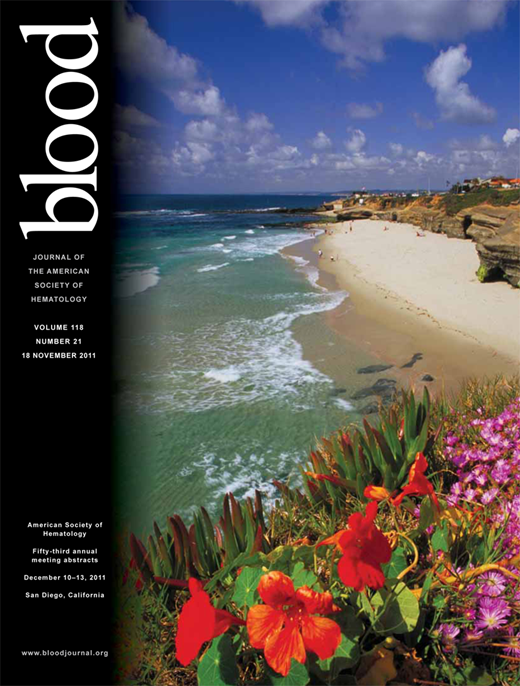Abstract
Abstract 3441
The translocation t(8;21)(q22;q22) is the most common cytogenetic abnormality in acute myeloid leukemia (AML), detected in around 15% of all cases. The translocation fuses the DNA binding domain of AML1 (RUNX1) to the almost full-length ETO (RUNX1T1, MTG8) protein converting a transcriptional modulator essential for hematopoiesis into a constitutive repressor. Expression of AML1/ETO in animal models is not sufficient for leukemogenesis, and further mutations are required. AML1/ETO has been detected in the Guthrie cards of pediatric patients who subsequently developed t(8;21) AML, suggesting that AML1/ETO+ hematopoietic precursor cells remain latent for many years before leukemic transformation. The mechanisms by which additional mutations are acquired are not well characterised.
AML1/ETO affects DNA repair gene expression and is associated with lower levels of 8-oxoguanine DNA glycosylase (OGG1) in patient samples and transduced primary CD34+ cells. OGG1 removes oxidatively damaged guanine bases from the DNA strand as an initial step of the base-excision repair pathway. Taken together, these observations suggest the existence of a pre-leukemic, AML1/ETO-expressing hematopoietic precursor which is susceptible to the acquisition of further DNA mutations by virtue of compromised DNA repair function.
In order to test this hypothesis we investigated the effect of AML1/ETO expression on susceptibility to spontaneous and exposure driven mutation in TK6 cells. TK6 lymphoblastoid cells have one functional copy of the thymidine kinase (TK) gene, allowing for quantification of mutant cells by functionally screening for the TK−/− phenotype. TK6 cells were lentivirally transduced with the pHR-SINcPPT-SIEW vector containing AML1/ETO; and EGFP as an expression marker. Expression was confirmed by flow cytometry, western blotting and qRT-PCR. Serial dilution assays were performed to generate AML1/ETO+ TK6 clonal populations with AML1/ETO expression varying from 10–150% of that found in Kasumi-1; a t(8;21)+ patient-derived cell line. We also used the PIGA gene as a second mutational target. Loss of this glycosyl-phosphatidylinositol (GPI) anchor results in an absence of GPI-linked proteins from the cell membrane, including CD55 and CD59. Cells that are simultaneously negative for two or more GPI-linked proteins are considered to be PIGA mutants and are detected using fluorochrome-conjugated antibodies.
Preliminary mutation results on AML1/ETO+ TK6 clones revealed that the fusion gene conferred an approximate 2 fold higher background TK−/− mutation frequency (MF) (2.1 × 10−6−2.6 × 10−6) compared to controls (0.9 × 10−61.1 × 10−6), and a 2–4 fold higher PIGA MF (Controls: 0.32 × 10−4−1.4 × 10−4 and AML1/ETO+ Clones: 2.7 × 10−4– 5.7 × 10−4), suggesting that AML1/ETO confers a moderate mutator phenotype even without exposure to genotoxic agents. Furthermore, spontaneous MF was proportional to AML1/ETO expression, with higher-expressing clones displaying a higher MF than lower expressers and control cells. When treated with low-dose doxorubicin (a chemotherapeutic anthracyline that induces strand breaks in DNA but can also generate reactive oxygen species (ROS)), AML1/ETO+ TK6 clones had a substantially higher TK−/− MF (0.5 × 10−5– 1.2 × 10−5) in comparison to controls; wild-type TK6 and backbone vector-alone transduced TK6 (1.8x 10−6−3.2 × 10−6) (p<0.001). Quantitative PCR revealed a significant 2-fold reduction in OGG1 levels in TK6 lentivirally transduced with AML1/ETO (p<0.05). Furthermore, siRNA mediated knockdown of AML1/ETO in the t(8;21)+ cell lines Kasumi-1 and SKNO-1 resulted in a substantial increase of OGG1, providing strong evidence that AML1/ETO directly regulates OGG1 expression. Consistent with downregulation of OGG1 and susceptibility to ROS-induced mutation, AML1/ETO+ clones had a 2–4 fold higher PIGA MF (0.6 × 10−3−1.3 × 10−3) compared to controls (1.6 × 10−4−3.3 × 10−4) when treated with hydrogen peroxide.
We have shown that AML1/ETO confers a mutator phenotype on cells that is associated with downregulation of OGG1, providing a plausible explanation for the particular susceptibility of AML1/ETO+ cells to mutation induction by agents that generate reactive oxygen species. This work suggests a mechanism by which AML1/ETO translocated pre-leukemic hematopoetic cells acquire additional mutations, ultimately leading to leukemic transformation.
No relevant conflicts of interest to declare.
Author notes
Asterisk with author names denotes non-ASH members.

